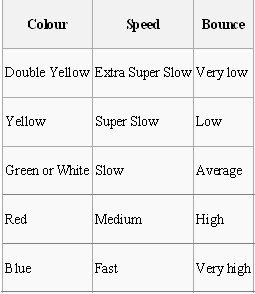
The game was formerly called squash racquets, a reference to the "squashable" soft ball used in the game (compared with the harder ball used in its parent game Racquets (or rackets; see below)).

 conditions and standards of play: more experienced players use slow balls that are smaller and have less bounce than those used by less experienced players (slower balls tend to die in court corners, rather than standing up to allow easier shots). Depending on its specific rubber composition, a squash ball has the property that it bounces more at higher temperatures. Small coloured dots on the ball indicate its dynamic level (bounciness), and thus the standard of play for which it is suited. The recognised speed colours indicating the degree of dynamism are:
conditions and standards of play: more experienced players use slow balls that are smaller and have less bounce than those used by less experienced players (slower balls tend to die in court corners, rather than standing up to allow easier shots). Depending on its specific rubber composition, a squash ball has the property that it bounces more at higher temperatures. Small coloured dots on the ball indicate its dynamic level (bounciness), and thus the standard of play for which it is suited. The recognised speed colours indicating the degree of dynamism are:
Balls are manufactured to these standards by Prince, Dunlop, Pointfore, Wilson, Black Knight and others. The "double-yellow dot ball", introduced in 2000, is currently the competition standard, replacing the earlier "yellow-dot" that was long considered the competition standard. There is also a high-altitude "orange dot" ball, used in places such as Mexico City, Calgary, Denver, and Johannesburg. In North America, the Dunlop "green dot" ball is often used at high altitude, as well.
Other balls available are:
a. Dunlop "Max Blue" (aimed at beginners), which is 12% larger and has 40% longer "hang time" than a "double-yellow dot ball" and has "instant bounce"

b. Dunlop "Max Progress" (red) (for players wishing to improve their technique), which is 6% larger with a 20% longer hang-time than a "double-yellow dot ball" and has instant bounce

Given the game's vigorousness, players wear comfortable sports clothing and robust indoor (non-marking) sports shoes. In competition, men usually wear shorts and a t-shirt or a polo shirt. Women normally wear a skirt and a t-shirt or a tank top, or a sports dress. Towelling wrist and head bands may also be required in humid climates. Polycarbonate lens goggles are recommended, as players might be struck with a fast-swinging racket or the ball, that typically reaches speeds exceeding 200 km/h (125 mph). In the 2004 Canary Wharf Squash Classic, John White was recorded driving balls at speeds over 270 km/h (170 mph). Many squash venues mandate the use of eye protection and some association rules require that all juniors and doubles players must wear eye protection.


No comments:
Post a Comment